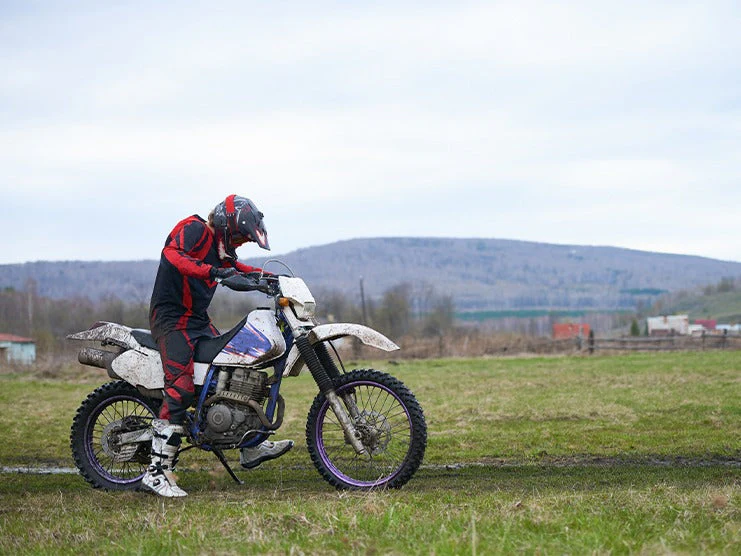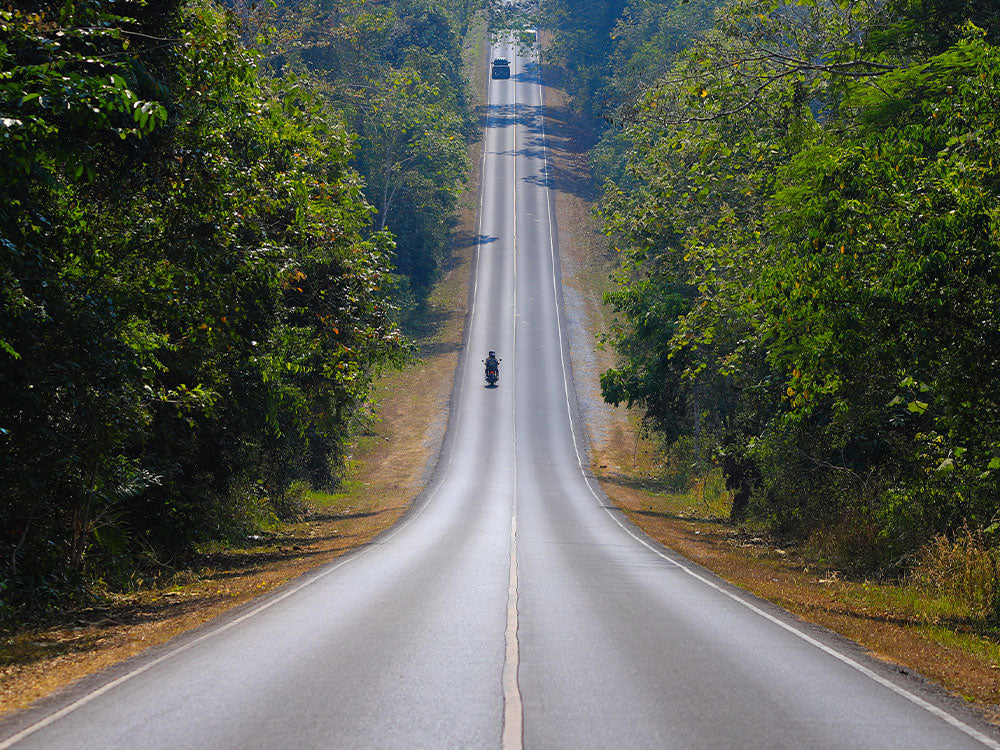Green lanes are roads not covered with hard covers like tarmac. Riding your motorcycle on a green laning gives you the opportunity to explore natural landscapes.
This article provides a guide on what is green laning.
Table of Content
1. What is Green Laning?

Green lanes are unmetalled legal roads with a surface not made of pavement, stone, etc. These roads are covered in vegetation, mud, sand, and stone, making them challenging to navigate.
While the majority of green lanes are accessible to all drivers, others are limited to specific vehicles. These roads are subject to limitations imposed by a traffic regulation order.
There are two types of green lanes:
- Byway Open to All Traffic (BOAT)
- Unclassified County Roads (UCR)
2. Is Green Laning the Same as Off-Roading?
These terms are often used interchangeably, but they refer to different concepts. Green laning involves exploring unpaved paths and routes. Off-roading involves avoiding established roads.
In general, riding on any route with rough terrain is considered off-roading. Meanwhile, green laning is a type of off-roading that involves traveling unpaved rural roads or former public roadways that are no longer paved.
3. Are All Green Lanes Driveable?
No. Some green lanes make it impossible to get through with even a two-wheeler or may violate road laws.
Green lanes on maps with UCR markers are usually large enough for a vehicle to pass. Look for roads surrounded by solid or dashed lines (representing fenced or unfenced roads).
Not all green lanes are open year-round due to the terrain constantly changing with the seasons. Most green lanes are best ridden during the summer when the terrain is firmer. It is advised you avoid riding on muddy green lanes during the winter.
4. Why Should You Go on Green Lanes?
Riders spend more time stuck in traffic jams these days than exploring. If you like to add a little adventure to your riding routine, jump on your two-wheeler and head off to explore the hidden trails.
Green laning along the byways and unrestricted roads can give you the opportunity to explore and test your driving skills.
5. Is Green Laning Legal?
Green laning is legal if your motorcycle is road legal and you possess a valid driver’s license, MOT certificate, road tax, and insurance. For you to be permitted to ride on a green lane, your vehicle’s specifications and features must be in compliance with all applicable road laws.
Green laning is legal as long as you follow the approved routes. It is your responsibility to conduct research regarding the permitted routes and any riding restrictions.
6. How to Find Green Lanes?
You can locate the nearest green lanes by getting a copy of an OS map showing your intended destination. Look for these routes on the map and check the key for symbols correlating with right-of-way signs for motorcycles. Carefully plan each step of your entire trip since not all rights of way signs mean they are always accessible.
Additionally, different maps may have different symbols assigned to the same routes. Check the start and end of the routes to see whether there are any bylaws in effect.
Many green lanes are only a few hundred meters long, while others can be several miles. However, the difficulty of the roads varies between them. It is often more rewarding to plan a route that incorporates several lanes that connect to each other.
You can also join a local green laning group to learn about possible routes and locations from websites. Maps can also be found online by doing a quick search on the web. Websites like www.bywaymap.com are helpful resources, but they should only be used as a tool to find routes as they may not tell you if motorcycles have a right-of-way. Always do your research and make thorough travel plans before you depart.
7. Can I Go Green Laning By Myself?
While possible, it is not recommended, especially for beginners.
Accidents do not often occur on green lanes, but they still happen. You do not want to find yourself stranded along a green lane far from civilization. It is best you travel with a partner who can provide support, call for help, or help you make repairs.
8. What Tools Should I Carry When Green Laning?
In case your motorcycle breaks down, you should carry the appropriate tools to make repairs. Take the appropriate plug and air pump to repair tubeless tires. For tubed tires, carry tire levers, a puncture repair kit, and extra tubes. A tire sealant like Slime can temporarily patch a hole without affecting handling if you travel at low speed. A small box of cable ties, an extra chain link, a tube of plastic weld, and some wire thread would also be useful additions.
Keep in mind that if you're riding on wet terrain, there's a possibility that your motorbike’s engine can become flood, requiring you to remove the spark plugs and let the water drain.
9. How to Stay Safe on Green Lanes?
Even if trail riding involves riding at slower speeds, there is still a high risk of falling off your ride. Take it slow and don't ride faster than you can handle, especially if you are still new to riding a motorcycle. In addition, try to avoid hiking alone as many paths might be secluded.
It is best to carry and know how to use a first-aid kit. Learn the basics of how to apply a splint or put someone in the recovery position.
Take into account how much time you spend on trails since it can be a physically and mentally demanding activity. Do not overextend yourself when riding to the point of fatigue.
10. What Are the Best Tires for Green Lanes?
Choosing the best tires for green laning depends on the type of vehicle you ride. A trail bike with a 21-inch front wheel and an 18-inch rear wheel is a suitable example.
Trail tires like Dunlop Trailmax or Michelin Anakee 3 aren’t suited for off-roading since they easily lose traction when traveling over wet terrain.
Mid-way tires like Continental TK70 or Heidenau K60 offer decent mileage and better grip. However, they offer little traction on muddy terrain.
Other tires best suited for green lanes are Metzeler Karoo 3, Continental TKC80, and Michelin Anakee Wild since they offer better grip for larger adventurous motorcycles.
11. Tips for Green Laning
11.1 Don’t Go Alone
If you are a beginner, you shouldn’t travel a green lane alone. Make sure to travel with a more experienced partner who knows how to travel off-road. You are more likely to get stuck in the mud and puncture your tires if you are inexperienced in offroading.
11.2 Look Up
When riding a motorcycle, keep your eyes peeled on the road ahead so you can spot any obstacles or rough terrain.
11.3 Stand Up
Remaining seated on your motorbike may increase the motorcycle’s center of gravity which can cause a decrease in speed. Standing up ensures a lower center of gravity and a better view of the road ahead.
11.4 Pack Essentials
Green laning burns a lot of calories, even if you travel for only a few hours. Pack water and food to help replenish your energy. Also, carry a first aid kit and a tool kit.
12. Last Words
Green laning involves riding on unpaved roads. A street-legal vehicle is required to ride on green lanes and requires you to follow all the rules of the roads. Riding on green lanes can be a challenge for beginners. You should have your ride equipped with necessary items in your SADDLEBAGS, Tank Bag, Tail Bag, and Backpacks.













Leave a comment
All comments are moderated before being published.
This site is protected by hCaptcha and the hCaptcha Privacy Policy and Terms of Service apply.